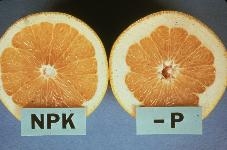It is more than just the confusion about the effects of phosphonates, but also how to spell the words associated with the P atom. Phosphorus with an ending in “us” is the element we know as P, while Phosphorous with a “ous” ending is the adjective of P. So an acid containing Phosphorous acid is written H3PO3 while phosphoric acid is H3PO4. These are both strong acids and can hurt and cause damage if splashed on the skin. When either is reacted with calcium or potassium hydroxide, a salt is formed which is less dangerous to users, but as with any chemical can be misused.
The salt formed from Phosphorous acid is called calcium phosphite or calcium phosphonate depending on what naming system is used to describe it. Whereas when these bases are reacted with phosphoric acid, the result is calcium or potassium phosphate. These salts are relatively benign in contact with skin. Labels on containers often call phosphorous acid, “soil applied” whereas the phosphite forms are called “leaf applied”. The “soil applied” when applied to a leaf can cause damage, whereas, the leaf applied is much less likely to cause damage to both plant and applicator. It can be applied to the soil, as well. It's much safer to use the leaf applied in either application technique.
The phosphites are often registered as fertilizers, but they have little nutrient effect. Most of their effect is to boost the plant's immunity to Phytophthoras and pythiums. This is called fungistasis and the material is called a fungistat. They don't act as a fungicide when normally applied to kill these organisms.
So you can see there is a lot of confusion in the phosphorous world. Knowing the proper spelling, pronunciation and use is note only good grammar, it makes good farming.
To read more, see:
http://plantscience.psu.edu/research/centers/turf/extension/factsheets/phosphonate-products
https://edis.ifas.ufl.edu/hs254
http://grammarist.com/spelling/phosphorous-phosphorus/
There are few documented cases of phosphorus (P) deficiency in tree crops in California.
Attached Images:
